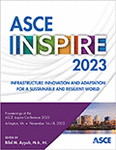Improving Geostationary Satellite-Based Prediction of Wildfire Spread by Directional Rate of Spread Adjustment Factor
Publication: ASCE Inspire 2023
ABSTRACT
This study proposes a “Directional” Rate of Spread (ROS) adjustment factor approach, which applies different ROS adjustment factors depending on the location of the wildfire spread region, even for the same fuel model. Using the observation data gathered by geostationary satellites, the directional ROS adjustment factor is estimated based on the least-squares method. In addition, a new methodology is proposed to indirectly improve the prediction accuracy of regional-scale wildfire spread simulators by using a directional ROS adjustment factor. Since geostationary satellites can obtain observation data at short time intervals, we identify the relationship between the directional ROS adjustment factor and correct the adjustment factors based on the locations and times of the newly detected pixels in the geostationary satellite data and the fuel model distribution of the surrounding pixels. The proposed methodology is demonstrated through the 2020 Creek Fire in California, United States. The results confirm that the proposed methodology and the directional ROS adjustment factor can significantly increase the wildfire spread prediction accuracy.
Get full access to this article
View all available purchase options and get full access to this chapter.
REFERENCES
Evensen, G. (2009). Data assimilation: the ensemble Kalman filter. Springer Science & Business Media.
Finney, M. A. (1998). FARSITE, Fire Area Simulator--model development and evaluation. US Department of Agriculture, Forest Service, Rocky Mountain Research Station.
Finney, M. A. (2003). “Calculation of fire spread rates across random landscapes.” International Journal of Wildland Fire, 12(2), 167–174.
Frandsen, W. H. (1971). “Fire spread through porous fuels from the conservation of energy.” Combustion and Flame, 16(1), 9–16.
LANDFIRE. (2016). 40 Fire Behavior Fuel Models-Scott/Burgan, LANDFIRE 2.0.0, U.S. Department of the Interior, Geological Survey. https://www.landfire.gov/viewer/ (accessed 20 April 2023).
Mandel, J., Chen, M., Franca, L. P., Johns, C., Puhalskii, A., Coen, J. L., Douglas, C. C., Kremens, R., Vodacek, A., and Zhao, W. (2004). A note on dynamic data driven wildfire modeling. In International Conference on Computational Science (pp. 725–731). Springer, Berlin, Heidelberg.
Mandel, J., Bennethum, L. S., Beezley, J. D., Coen, J. L., Douglas, C. C., Kim, M., and Vodacek, A. (2008). A wildland fire model with data assimilation. Mathematics and Computers in Simulation, 79(3), 584–606.
Mohapatra, A., and Trinh, T. (2022). Early Wildfire Detection Technologies in Practice—A Review. Sustainability, 14(19), 12270.
Myoung, B., Kim, S. H., Nghiem, S. V., Jia, S., Whitney, K., and Kafatos, M. C. (2018). Estimating live fuel moisture from MODIS satellite data for wildfire danger assessment in Southern California USA. Remote Sensing, 10(1), 87.
Richards, G. D. (1990). “An elliptical growth model of forest fire fronts and its numerical solution.” International journal for numerical methods in engineering, 30(6), 1163–1179.
Rothermel, R. C. (1972). A mathematical model for predicting fire spread in wildland fuels (Vol. 115). Intermountain Forest & Range Experiment Station, Forest Service, US Department of Agriculture.
Rothermel, R. C. (1983). Field procedures for verification and adjustment of fire behavior predictions. US Department of Agriculture, Forest Service, Intermountain Forest and Range Experiment Station.
Schmidt, C. (2020). Monitoring fires with the GOES-R series. In The GOES-R Series (pp. 145–163). Elsevier.
Van Leeuwen, W. J. (2008). Monitoring the effects of forest restoration treatments on post-fire vegetation recovery with MODIS multitemporal data. Sensors, 8(3), 2017–2042.
Weather Underground. (September 4, 2020). Reno, NV Weather History for Friday, September 4, 2020 to Thursday, September 10, 2020. https://www.wunderground.com/history/weekly/us/ca/fresno/KFAT/date/2020-9-4 (accessed 25 April 2023).
Information & Authors
Information
Published In
History
Published online: Nov 14, 2023
ASCE Technical Topics:
- Aerospace engineering
- Analysis (by type)
- Climates
- Disaster risk management
- Disasters and hazards
- Energy engineering
- Energy sources (by type)
- Engineering fundamentals
- Environmental engineering
- Fires
- Fuels
- Least squares method
- Man-made disasters
- Natural disasters
- Non-renewable energy
- Regression analysis
- River engineering
- Rivers and streams
- Satellites
- Space exploration
- Statistical analysis (by type)
- Water and water resources
- Wild fires
Authors
Metrics & Citations
Metrics
Citations
Download citation
If you have the appropriate software installed, you can download article citation data to the citation manager of your choice. Simply select your manager software from the list below and click Download.
